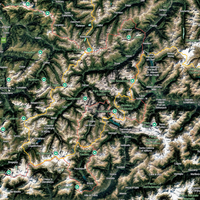The Danube River basin of Switzerland.
Rivers and streams.
Only a small part of Switzerland lies within the Danube River Basin, located in the eastern Swiss Alps. The basin here is represented by the Inn River (En) and its alpine tributaries, which rise in the Engadin Valley of the canton of Graubünden. These headwaters are among the highest and coldest in the entire Danube system, characterized by crystal-clear water, steep gradients, and pristine alpine scenery.
Inn River (En)
The Inn, known locally as the En, originates near the Maloja Pass in the Upper Engadin, close to the village of Lunghin. It flows northeast through the Engadin Valley before entering Austria at Martina. The river’s Swiss reaches are fast-flowing and cold, providing excellent habitat for brown trout, grayling, and Lake char (Salvelinus umbla) in nearby alpine lakes. The Engadin stretch of the Inn is highly valued for its scenic beauty and clean waters.
Ova da Spöl
The Ova da Spöl flows out of Lago di Livigno and through the Swiss National Park before joining the Inn near Zernez. It is the same river system as Italy’s Fiume Spol, continuing its journey northward into Switzerland. The Swiss section is a high-elevation stream with limited fishing access due to its protected status, but it plays an important ecological role, supporting brown trout and grayling populations.
Tributaries of the Engadin
Several smaller tributaries feed the Inn within Switzerland, including the Ova da Cluozza, Ova da Bever, and Ova dal Fuorn. These cold alpine streams are vital spawning and nursery grounds for salmonids. They host brown trout, grayling, and occasionally rainbow trout, depending on altitude and accessibility.
Fishing Management.
Fishing in the Swiss part of the Danube Basin is managed at the cantonal level, primarily by the Canton of Graubünden. The Inn and its tributaries are regulated under local fishing districts, with certain stretches leased to angling clubs or associations. The Swiss National Park and some upper reaches of the Inn and Ova da Spöl are protected areas where fishing is prohibited to preserve natural ecosystems.
Regulations.
Anglers must hold a valid Swiss fishing license (usually issued by the canton) to fish in the Inn and its tributaries. Regulations define fishing seasons, catch limits, and methods—most salmonid waters are fly- or spin-fishing only. Fishing is typically allowed from May or June until September or October, depending on altitude and conditions. Catch-and-release sections are common, especially in the upper Engadin.
Guides.
- To be updated.
